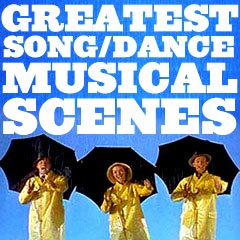
|
Musical Moments and Scenes G - 1 |
| G | |||||||||||
| Movie Title/Year and Scene Descriptions | |||||||||||
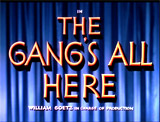
|
The Gang's All Here (1943) Busby Berkeley directed and choreographed this amazing and fascinating Fox film (it was his sole Fox film, his first Technicolor film, and the first film that he both directed and choreographed). It starred Alice Faye and the outrageously-vivacious Brazilian bombshell Carmen Miranda.
|
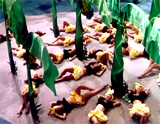 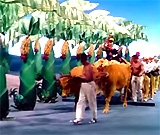 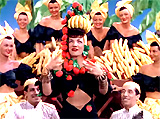 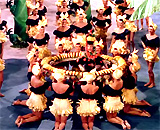  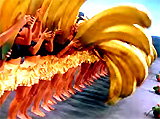    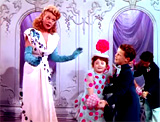  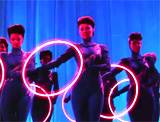 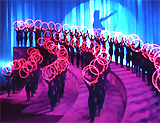   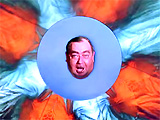
|
|||||||||
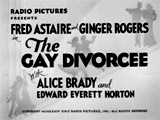
|
The Gay Divorcee (1934)
This RKO film by director Mark Sandrich was the second pairing of Fred Astaire (as amorous dancer Guy Holden) and Ginger Rogers (as Mimi Glossop) in their first starring roles in a film. It had a total of five Oscar nominations, including Best Picture, Best Sound, Best Art Direction, and Best Musical Score, and won its sole award for Best Original Song (The Continental). It included two major song-and-dance numbers:
The film also included Astaire's early solo song and tap-dance A Needle in a Haystack (pictured) performed in a London hotel room in front of a fireplace (in which he changed from a dressing gown to a tie and jacket during the number). In addition, Edward Everett Horton's (as Egbert 'Pinky' Fitzgerald) song/dance number with a young Betty Grable (credited as "Dance Specialty") was titled Let's K-nock K-neez - in the number, the back-up dancers were dressed in period bathing suits. |
  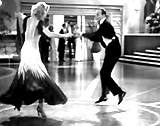 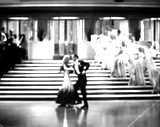 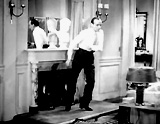 
|
|||||||||

|
Gentlemen Prefer Blondes (1953)
In a film advertised as having "The Two M-M-Marvels Of Our Age In The Wonder Musical Of The World!", gold-digger Lorelei Lee (Marilyn Monroe) dazzled with her pink-dress show-stopping performance of Diamonds Are A Girl's Best Friend (pictured) - her most famous musical number. Madonna famously copied Diamonds Are A Girl's Best Friend for her music video of Material Girl - both songs were merged for the showstopping Sparkling Diamonds medley in Baz Luhrmann's Moulin Rouge! (2001), performed by Nicole Kidman. The film also exhilarated with:
|
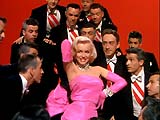 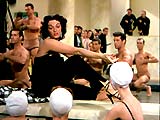 
|
|||||||||
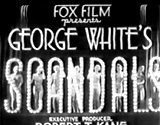
|
George White's Scandals (1934) This 1934 pre-Code Busby Berkeley-inspired Fox film was the first of two productions based upon the Ziegfeld Follies-like stage spectacles of legendary Broadway impresario George White. [Note: The second version was George White's 1935 Scandals (1935) the following year, featuring the film debut of Eleanor Powell.] The 1934 film featured stars Rudy Vallee (as entrepreneur Jimmy Martin), Jimmy Durante (as Happy McGillicuddy), and Alice Faye (as aspiring singer Kitty Donnelly/Mona Vale, in her film debut). During the lurid and saucy (Oh, You) Nasty Man! (pictured twice) number, Faye wore a skimpy costume while appearing with rows of dancing chorines (called the White "Scan-Dolls"). Another voyeuristic number (a sing-along) was titled Hold My Hand (pictured) in which the dancers lifted their white gowns and waved their skirts. The film also featured Jimmy Durante's infamous performance of Cabin in the Cotton (pictured) in blackface, with the Scan-Dolls costumed in polka-dotted outfits, picking cotton, with figures of black males strapped to their middles. |
  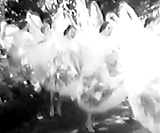 
|
|||||||||

|
Ghost (1990)
Director Jerry Zucker's popular romantic melodrama (and slightly supernatural ghost-story film) was honored with an Academy Award nomination for Maurice Jarre's Original Musical Score. It told about the love between:
During an early scene in the beginning of the film, a 45 rpm record was loaded in a jukebox. Molly sat her hypnotically-spinning pottery wheel (in an oft-parodied sequence) where she sensuously molded, formed and sculpted a phallic-shaped clay object to the tune of Unchained Melody (pictured) (the 1965 recording by the Righteous Brothers) when she couldn't sleep (it was 2 am). Shirtless Sam came up behind her and kissed his lover Molly as he was seated behind her. He assisted her in reshaping a collapsed piece of pottery (her failed "masterpiece") by putting his hands together with hers, as she instructed:
The sequence continued with their extended love-making and kissing ("hunger for your love") in their darkened apartment. |
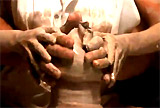 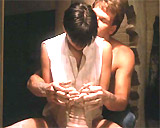 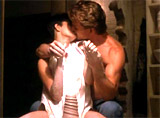 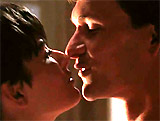 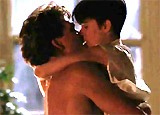
|
|||||||||

|
Gigi (1958)
This profitable Best Picture-winning MGM song musical with music and lyrics by Lerner and Loewe, was directed by Vincente Minnelli and showcased Cecil Beaton-designed costumes and sets. Its soundtrack was the first ever to receive a Grammy. It was a remarkable film, winning all nine of its Academy Award nominations: Best Picture, Best Director, Best Adapted Screenplay (Alan Jay Lerner), Best Cinematography, Best Costume Design, Best Art Direction, Best Film Editing, Best Score (Andre Previn), and Best Song (music by Frederick Loewe and lyrics by Alan Jay Lerner). Having played the title role on the London stage, Leslie Caron was cast as Gigi, a trainee courtesan who grew up. It featured Maurice Chevalier's (as romantic boulevardier Honore Lachaille) famous renditions of Thank Heaven for Little Girls (pictured) and I Remember It Well (pictured), (a duet with Gigi's grandmother, Parisian courtesan Madame Alvarez played by Hermione Gingold). Other popular Lerner and Loewe songs were sung by cast members Leslie Caron, Chevalier, Louis Jourdan (as romantic interest Gaston Lachaille, Honore's wealthy young nephew) and Gingold. The best numbers included:
|
 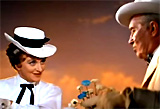   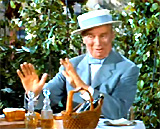
|
|||||||||
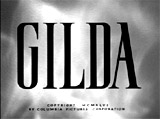
|
Director Charles Vidor's black and white classic film noir was about a destructive love triangle between:
The film's most memorable scene was Gilda's (Rita Hayworth, dubbed by Anita Ellis) bawdy, sexy casino performance/glove striptease, her signature number, while singing the torchy, defiant number Put the Blame on Mame (pictured). The lyrics of the song, filled with double entendres, described a dangerous, threatening kind of woman who was often blamed - unfairly and illegitimately - by men. Swathed in a black satin dress displaying bare upper arms and shoulders, she beckoned with extended arms toward the lusting men in the audience and peeled off one of her long, elbow-length black satin gloves - keeping the casino audience (and viewers) in suspense - wondering whether the strapless gown would remain suspended on her frame. Receiving accolades and encore-applause, Gilda flung her second glove toward the hungering audience. As she started to shed her strapless dress, she entreated the men for assistance before being dragged off the stage:
|
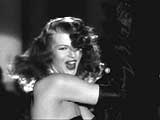 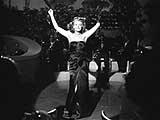
|
|||||||||

|
Gimme Shelter (1970) The Maysles Brother's haunting concert documentary film covered the 1969 British rockers' Rolling Stones tour that captured, in its finale, the stabbing to death on December 6th of fan Meredith Hunter (who waved a gun) by Hell's Angels "security" (who were paid with beer) at Altamont Speedway during the Altamont Free Concert near San Francisco. In the disturbing sequence, as the crowd increasingly became jittery, out-of control, and fights broke out during Mick Jagger's singing of "Sympathy for the Devil", he cautioned the audience:
As a doctor and ambulance was being summoned, Jagger continued to try to calm the listeners:
As Jagger proceeded to his final song: "Under My Thumb" - another violent scuffle broke out. The Hell's Angels - who had been hired locally to provide security, became involved in quelling the disturbance, as the Rolling Stones abruptly stopped their performance. Jagger spoke out again: "Hey, man, look. We're splitting. If those cats can't... If you people... We're splitting if those cats don't stop beatin' everybody up in sight. I want 'em out of the way, man. I don't like you..." The end of the film, set in an editing room, showed the Stones' Jagger watching film of the events - shocking footage of a murder committed in the crowd very near the stage - Hell's Angel Alan Passaro (as Himself) back-stabbed 18 year-old drugged-up spectator Meredith Hunter (as Himself) (who was wielding a long-barreled .22 revolver gun) - identified because he was wearing a bright lime-green suit. The documentary featured performances of the best-known Rolling Stones songs including:
|
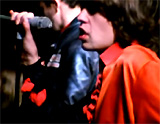   
|
|||||||||
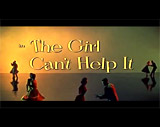
|
The Girl Can't Help It (1956) This late 50s comedy/musical film was most memorable for the 'acting' of buxom blonde star Jayne Mansfield as mobster Marty "Fats" Murdock's (Edmond O'Brien) untalented blonde moll Jerri Jordan. The role recreated Born Yesterday (1950) - in its story of Fats hiring alcoholic publicity agent Tom Miller (Tom Ewell) to train Jerri to be a rock 'n' roll singing star in just six weeks. In this spoof of the record industry, the musical performances from rock icons were classic, such as:
Spread the Word (pictured) was a musical performance made in front of a shimmering dark blue curtain in the Late Place Club by Abbey Lincoln (as Herself). Although Mansfield sang the dreamy Every Time It Happens (pictured) in the finale (a Rock 'N' Roll Jubilee) when accompanied by Ray Anthony and his band, her performance was dubbed. |
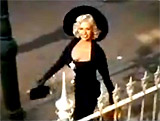    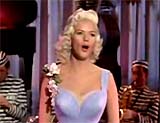
|
|||||||||

|
Girl Crazy (1943) This MGM musical adapted from the Broadway hit, by director Norman Taurog, was the best (and last that co-starred the pair) of the Mickey Rooney/Judy Garland "let's put on a show" feature-length musicals (this was their eighth film together). The film reprised Gershwin songs of the 30s and early 40s (played by the Tommy Dorsey Band). It featured Rooney (as New York playboy Danny Churchill, Jr. at a college in Cody, Wyoming) and Garland (as Ginger Gray) singing I've Got Rhythm (pictured twice) (directed by Busby Berkeley) in fringed white buckskin in the giant-scale western rodeo finale. Other numbers included:
|
  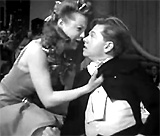  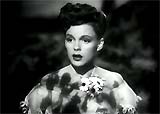
|
|||||||||
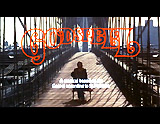
|
Godspell (1973) This off-Broadway hit of the early 70s was adapted for the screen - it was a fresh and innovative musical representation of the gospel of Matthew set in modern-day NY. It featured a number of astonishing and freshly-interpreted numbers:
|
     
|
|||||||||
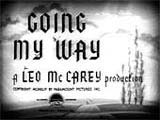
|
Going My Way (1944)
This highest-grossing 1944 picture was a sentimental comedy/drama. It had a total of ten Oscar nominations and won seven, including Best Picture, Best Actor (Bing Crosby), Best Director and Best Original Story (Leo McCarey), Best Screenplay, Best Supporting Actor (Barry Fitzgerald), and Best Song. Its other nominations were Best Actor (also Fitzgerald), Best Cinematography, and Best Film Editing. It featured Oscar-winning crooner Bing Crosby as a young priest (Father Charles "Chuck" O'Malley) who revitalized St. Dominic's parish and its elderly Irish priest (Father Fitzgibbon portrayed by Oscar-winning Barry Fitzgerald). Crosby's famous upbeat performance of the Academy Award-winning Best Song Swinging on a Star (pictured) occurred when he accompanied himself on the piano while surrounded by church youth (the Robert Mitchell Boys Choir). |

|
|||||||||
(alphabetical by film title) Introduction | A-1 | A-2 | B-1 | B-2 | B-3 | C-1 | C-2 | D-1 | D-2 | E | F-1 | F-2 | G-1 | G-2 H-1 | H-2 | I-J | K | L-1 | L-2 | M-1 | M-2 | N-O | P-1 | P-2 | R-1 | R-2 | S-1 | S-2 | S-3 | T | U-V | W | X-Z |